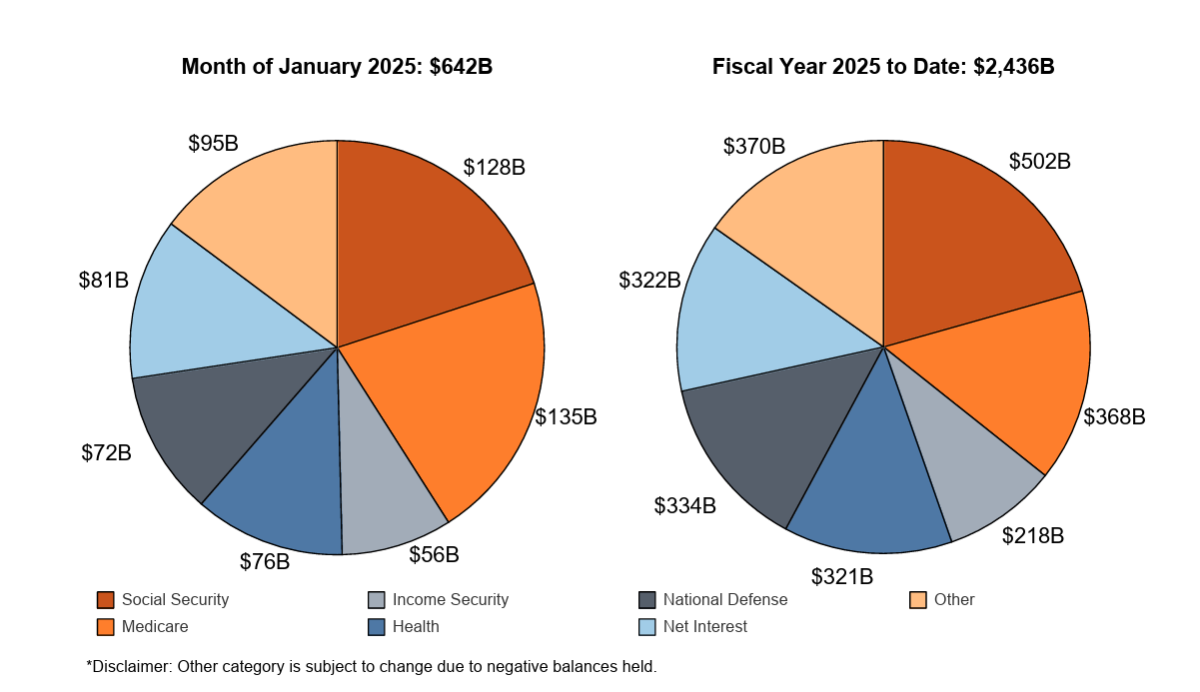Feds Run Record Budget Deficit Through First Four Months of Fiscal 2025
DOGE has got its work cut out for it.
Even as the new Department of Government Efficiency ferrets out wasteful spending, the constant budget deficits serve as a sobering reminder of just how much the federal government overspends month after month.
The January budget deficit came in at $128.64 billion, according to the latest Monthly Treasury Statement. That pushed the budget shortfall through the first four months of fiscal 2025 to a record $839.6 billion.
Uncle Sam took in $513.3 billion in tax receipts and revenue last month. That was a 7.5 percent increase over January 2024. So far, in fiscal 2025, government revenues total $1.6 trillion. That's roughly unchanged from the same period last year, but according to a Treasury Department official, the 2024 revenue figure was inflated by deferred tax payments from 2023 related to natural disasters.
The real problem is on the spending side of the ledger.
The federal government blew through $641.9 billion in January alone, pushing total spending in fiscal 2025 to $2.44 trillion. That represents a 15 percent increase in spending compared to the first four months of fiscal 2024.
You might recall that President Biden promised that the [pretend] spending cuts would save “hundreds of billions” with the debt ceiling deal (aka the [misnamed] Fiscal Responsibility Act).
That never happened.
The federal government continues to find new reasons to spend money, whether for natural disasters at home or wars overseas. The Biden administration spent a staggering $6.75 trillion in fiscal 2024, a 10 percent increase over 2023 outlays.
The federal government spent $83.8 billion to cover interest on the national debt in January. That brought the total interest expense for the fiscal year to $392.2 billion, up 9.8 percent over the same period in 2024.
So far, in fiscal 2025, the federal government has spent more on interest on the debt than it has on national defense ($334 billion) or Medicare ($368 billion). The only higher spending category was Social Security.
Uncle Sam paid $1.13 trillion in interest expenses in fiscal 2023. It was the first time interest expense has ever eclipsed $1 trillion. Projections are for interest expense to break that record in fiscal 2025.
Much of the debt currently on the books was financed at very low rates before the Federal Reserve started its hiking cycle. Every month, some of that super-low-yielding paper matures and has to be replaced by bonds yielding much higher rates. And even with the recent Federal Reserve rate cuts, Treasury yields have pushed upward as demand for U.S. debt sags.
Why Does It Matter?
These big deficits pile onto a national debt that officially topped $36 trillion in November.
Some people claim that borrowing, spending, and big national debts don't matter.
They do.
According to the national debt clock, the current debt level represents 122.99 percent of GDP. Studies have shown a debt-to-GDP ratio of over 90 percent retards economic growth by about 30 percent.
And as the Bipartisan Policy Center points out, the growing national debt and the mounting fiscal irresponsibility undermine the dollar.
“Confidence in U.S. creditworthiness may be undermined by a rapidly deteriorating fiscal situation, an increasing concern with federal debt set to grow substantially in the coming years.”
This could lead to lower economic growth, higher unemployment, and less investment wealth.
Lack of confidence in the U.S. fiscal situation could also lower demand for U.S. debt. This would force interest rates on U.S. Treasuries even higher to attract investors, exacerbating the interest payment problem. As already mentioned, we saw a big spike in Treasury yields despite Fed rate cuts.
Biden ran the debt higher at a dizzying pace, but to be fair, this isn’t just a Biden problem. Every president since Calvin Coolidge has left the U.S. with a bigger national debt than when he took office.
DOGE has done a great job of pointing out government waste, but it's going to take more to get the borrowing and spending under control. Even if the Trump administration manages to slash discretionary spending as promised, that only accounts for 27 percent of total spending. The vast majority is for entitlements, and there is little political will to take the scissors to Social Security or Medicare.
And the sad fact is that most people in positions of power are content to kick the debt can down the road. They reason, 'Nothing has happened yet, so why worry?' But the problem with playing kick the can down the road is that you eventually run out of road.
********








